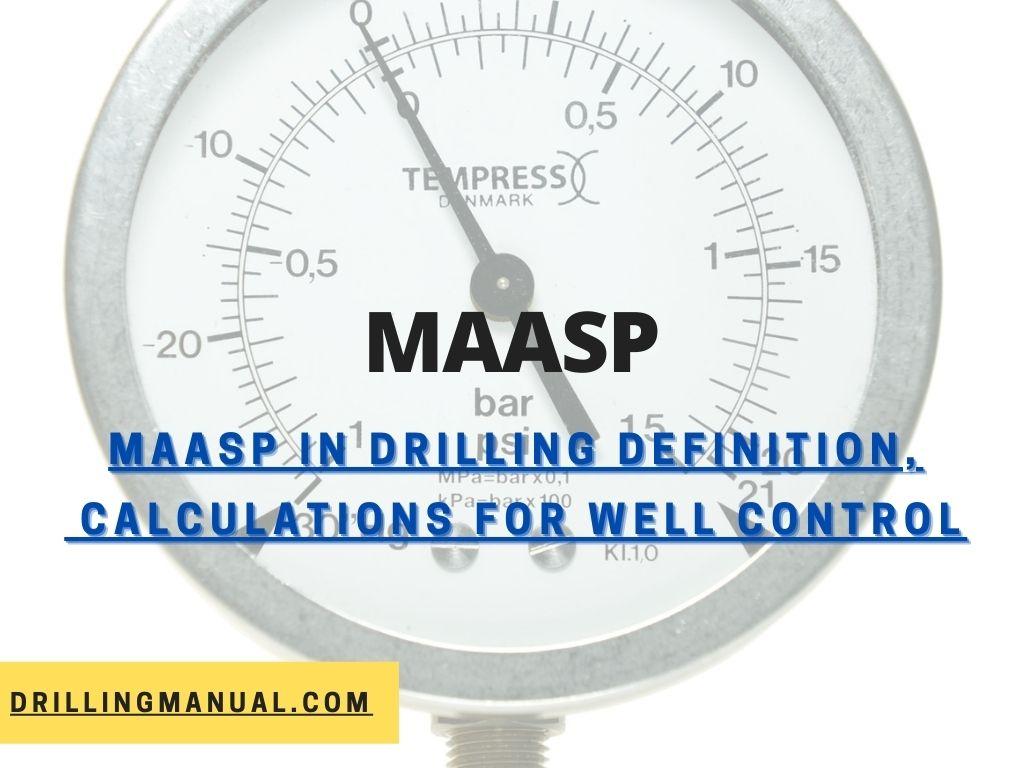During well control operations, the maximum allowable borehole fluid pressure at the casing shoe is normally considered to be the critical factor, based on the assumption that the weakest formation is at the shoe. For practical purposes, the corresponding pressure at the surface (Drilling MAASP or Maximum allowable annular surface pressure) is calculated through specific formulas and used during well control operations.

MAASP Definition
The MAASP is the maximum pressure that can be allowed to develop at the surface before the fracture pressure of the formation just below the casing shoe is exceeded. Remember that an increase in the annulus pressure at the surface will mean that the pressures along the entire wellbore are increasing also. Normally, the weakest point in a drilled well is the highest point in the open hole section (i.e., at the previous casing shoe).
In other words, the Maximum Allowable Annular Surface Pressure – MAASP – when drilling ahead is the maximum closed-in (not circulating) pressure that can be applied to the annular (drill pipe x BOP stack) at the surface before the formation just below the casing shoe will start to fracture (leak-off).
Why Is MAASP important?
During the well control operation, the pressure mustn’t be allowed to exceed the fracture gradient at this weakest point. The fracture pressure of the formation just below the casing shoe will be available from leak-off tests carried out after the casing was set. If no leak-off test was carried out an estimate can be made by taking a percentage of the minimum geostatic gradient for that depth.
Simple Considerations About Maximum Allowable Annular Surface Pressure
- If an influx occurs (check more about kick warning signs) and the well is killed with a kill mud by driller’s method or wait and weight method this calculation should be repeated to determine the new MAASP.
- The MAASP should not exceed 70% of the casing burst resistance.
- Some control panels of remotely controlled chokes have an automatic MAASP control feature, which does not allow the choke pressure Pch to exceed the pre set MAASP. When this feature is used in situations whereby MAASP should be exceeded, for instance, when top influx is already inside the casing shoe, more influx is allowed to enter the hole unnecessarily, which may lead to worsening situations. It is recommended not to use this feature but to manually adjust the remotely controlled choke(s) from the control panel.
MAASP Calculations
The MAASP can be determined from the following equation: MAASP = Maximum Allowable Pressure at the formation just below the shoe minus the Hydrostatic mud pressure at the formation just below the shoe.
MAASP is normally calculated immediately after a leak-off test and is then adjusted whenever mud density changes. Data from leak-off tests are combined with the current drilling fluid gradient to generate the MAASP value. Given a known drilling fluid gradient, it is possible to express the Formation Strength as a Maximum Allowable Annular Surface Pressure (MAASP) that may be applied in addition to the fluid column before the formation strength pressure is exceeded. This can be calculated as:
MAASP = Dshoe x (EMMG-ρfluid)
EMMG: Equivalent Maximum Mud Gradient can be calculated from the following equation
EMMG = Maximum pressure at shoe / Shoe depth( tvd – bdf)
Given that this value depends on the fluid gradient, Pfluid, from the surface to the casing shoe, the recorded MAASP value must be amended whenever the drilling fluid density changes. In addition, when an influx/kick – particularly gas – passes the shoe and enters the casing, the hydrostatic pressure associated with the fluid column to surface alters dramatically and so negates the previously calculated MAASP value.
Example On Maximum Allowable Annular Surface Pressure Calculations
Problem:
A leak-off test was carried out just below a 13 3/8″ casing shoe at 7000 ft. TVD using 9.0 ppg mud. The results of the tests are shown below. What is the maximum allowable mud weight for the 12 1/4″ hole section?
| BBLS PUMPED | SURFACE PRESSURE (psi) |
| 1 | 400 |
| 1.5 | 670 |
| 2 | 880 |
| 2.5 | 1100 |
| 3 | 1350 |
| 3.5 | 1600 |
| 4 | 1800 |
| 4.5 | 1900 |
| 5 | 1920 |
If a mud weight of 9.5 ppg is required to drill the 12 1/4” hole section of the above well what would the MAASP be when drilling this hole section?
Solution
If a mud weight (check mud balance testing) of 9.5 ppg mud is required to drill the 12 1/4” hole section of the above well, the MAASP when drilling this hole section would be:
Since the maximum allowable mud weight in the next hole section is 13.95 ppg
The pressure at the casing shoe with 13.95 ppg mud: 13.95 x 0.052 x 7000 = 5078 psi
The pressure at the casing shoe with 9.5 ppg mud: 9.5 x 0.052 x 7000 = 3458 psi
The MAASP is therefore = 5078 – 3458 = 1620 psi
Ref: Shell well control manual, Heroit Watt Master book For drilling engineers
Do not we need to calculate the fruc gradient?